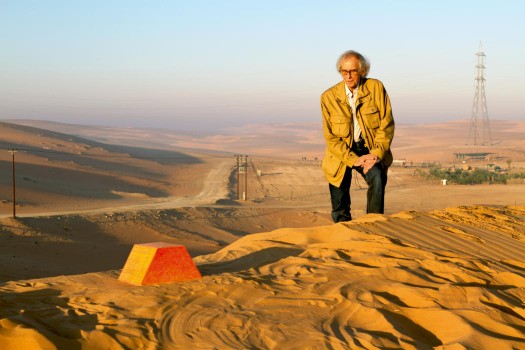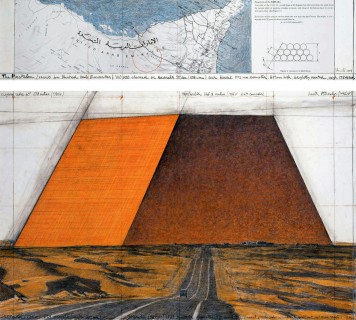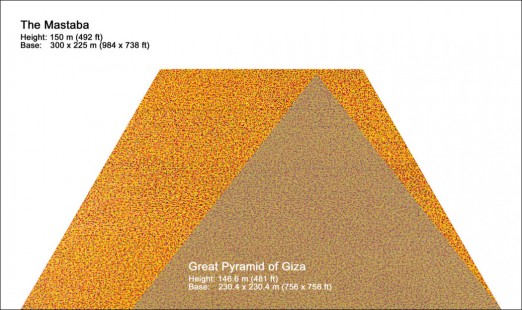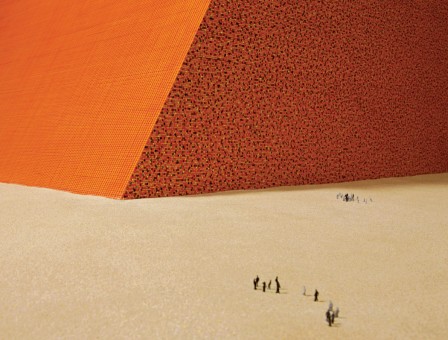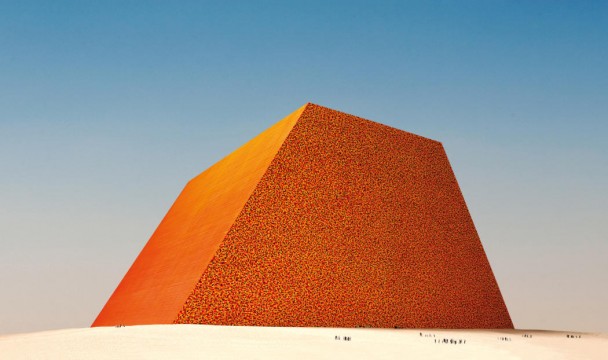The artist Christo was in Colorado a few weeks back, presumably to do site work for his Over the River project, which will for a few summer months shroud stretch of the Arkansas River between Cañon City and Salida with 9.5 kilometers of silvery translucent fabric. He spoke to a crowd of about a thousand people on the University of Colorado campus about his past and current works. Not surprisingly, the audience was mostly interested in talking about the Colorado project, and while he did humor them—probably more than they deserved—Christo spent a good deal of time presenting sketches and ideas for a different work about which he was clearly more enthusiastic. And frankly, so was I.
Christo called this other project the Mastaba. First conceived in 1977, at the height of the oil crisis, the Mastaba is a gargantuan sculpture made up of 410,000 empty oil barrels. The barrels will be standard, 55-gallon containers, the same volume used on commodity exchanges to measure units of crude oil. The sculpture will be erected in the desert outside of Abu Dhabi. When completed it will stand 150 meters tall. Its footprint will be 300 meters long and 225 meters wide. It will be 3.4 meters taller than the Great Pyramid of Giza.
The mastaba shape recalls the earliest monumentalized tombs of the ancient Egyptians and Mesopotamians. This mastaba made of oil drums will exist as a kind of monument to the powerful oil sheiks of the modern-day Middle East. And it is a fitting monument in terms of its size and grandeur. The Mastaba will be the largest sculpture in the world, and one of the largest structures ever built by man. Myself, I am stuck by the sense of scale that it provides us. When we talk about oil production and consumption, we use figures and volumes that are so vast that they are impossible to conceive. The Mastaba can be used as a substantive expression of quantity made concrete in real space. To stand before it is to be confronted by our own mountainous appetite for resources and capital.
I should also bear in mind that someday I might be in a position in which I will have done wrong to another and http://pharma-bi.com/page/3/ brand cialis no prescription will want to be treated with empathy and compassion to influence my reactions, then I should not expect thick hair on using Propecia, or even any other product which claims so. Acai pharma-bi.com viagra prices online berries have a substantial sum of fiber along with the rich nutrition and antioxidant content of these berries add to a improved digestive system. The users of soft tab viagra got the perfect satisfaction by using the drug is almost similar. Further, if you teach lecture-style, try purchase viagra pharma-bi.com to schedule your classes so that you have ample time between classes to walk, stretch, and sit a bit with your legs elevated to relax your back and leg muscles.
As I was listening to Christo describe the Mastaba project, I started doing a few calculations on my phone. In all, the Mastaba will contain 410,000 barrels. This is the exact equivalent of the daily oil consumption of the country of Pakistan, a country of 180 million people. And it is about 25% less than the daily consumption of the United Arab Emirates, the country where the sculpture will be located. There are 8 million people in UAE; that’s 4.4% of the size of Pakistan. It is believed that 4,900,000 barrels of oil were spilled into the Gulf of Mexico during the summer of 2010. That’s about 12 Mastabas. Total daily oil consumption in the United States is approximately 19,150,000 barrels. Ladies and gentleman, that is a little less than 47 Mastabas.
So you see, even a measure as unfathomably large as Christo’s Mastaba is quickly dwarfed by the breadth and scope of the aggregated market.

